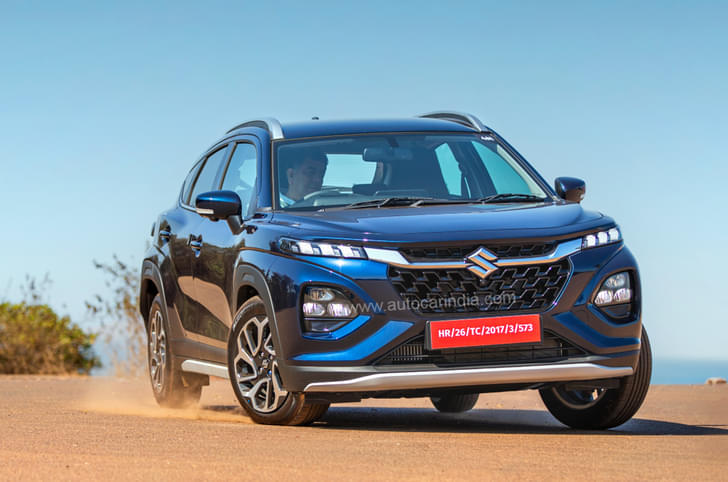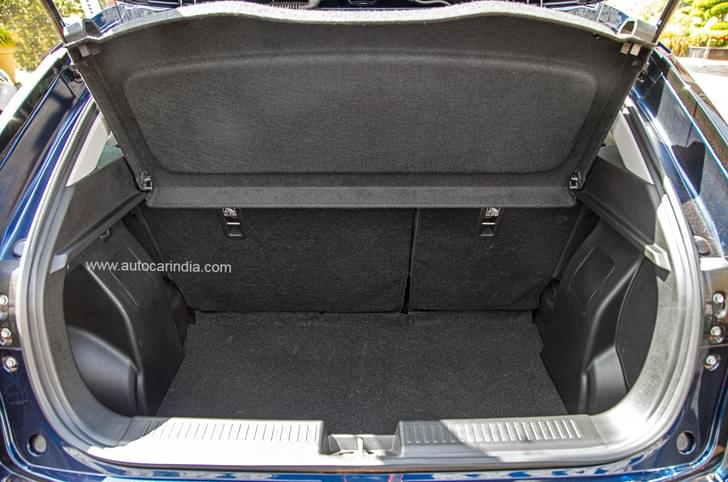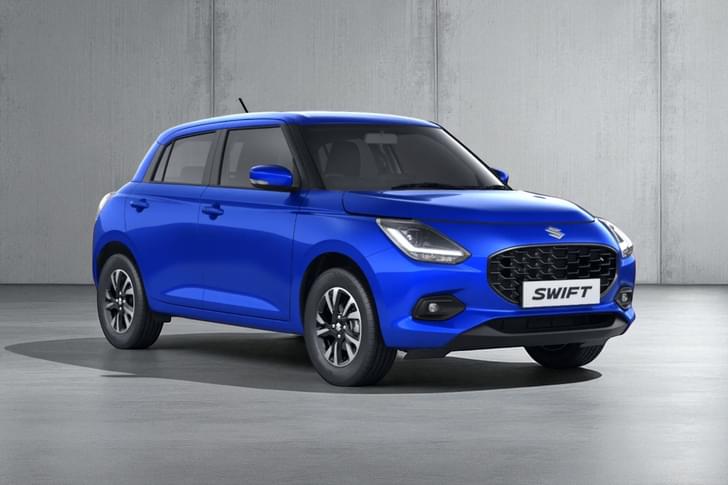The Fronx – first showcased at Auto Expo this January – is an intrinsic part of Maruti Suzuki’s strategy to make up for the lost time in the SUV market. Having dominated the compact and budget car market for almost four decades, Maruti Suzuki was happy in its comfort zone and didn’t bother to capitalise on the booming SUV market. It was a strategic blunder that saw the competition run away with the fastest-growing and most lucrative slice of the market. But it’s never too late to join the race and India’s number one carmaker is now rolling out a slew of new SUVs. The Fronx is one of them.
Maruti Suzuki Fronx exterior design
But the Fronx isn’t exactly an SUV as much as Maruti Suzuki would like you to believe. It’s based on the Baleno so its roots are deep in hatchback territory, and a Baleno on stilts is what we (perhaps a tad uncharitably) expected. But when we first clapped eyes on the Fronx at Auto Expo, we could understand why Maruti Suzuki kept beating the SUV drum. When the covers came off, we weren’t just suitably impressed, but pretty shocked with what we saw. To be honest, design and styling isn’t a Maruti Suzuki strength, so expectations weren’t high and we assumed the Fronx would be another lazy job of sticking a few scuff plates and a bit of plastic cladding on the Baleno.
 (1).jpg?w=700&c=0)
But no, the Fronx’s designers have done an outstanding job in transforming the Baleno hatchback into something that – from certain angles – has a genuine SUV presence. In fact, from the front, the Fronx is more Grand Vitara than the Baleno and is its most appealing angle. The raised bonnet, big grille and deep chin give its front strong SUV credentials, but the talking point is the fantastic light treatment: DRL strips at the top and a triangular headlight cluster with three projector lamps (halogens for the Delta and Sigma variants, and LEDs for the higher ones) set deep inside their housings. However, there are no fog lights or any provision to retrofit them, just like with the Grand Vitara.
.jpg?w=700&c=0)
The rear, which has a completely new tailgate, also bears no resemblance to the Baleno, and is distinguished by a pair of slim tail-lamp clusters connected with a light strip and a pronounced scuff plate that rises quite high up from under the bumper. The fenders have squared-off wheel arches and the doors, which look the same as the Baleno’s, actually have a different cross-section and thickness. The glasses are all carried over from the Baleno, so the Fronx gets the same coupe-like silhouette, and hence calling it an SUV-coupe, a newly invented term and category, would kind of position it the most accurately.
 (1).jpg?w=700&c=0)
It's also from the side that you notice the Fronx’s generous 190mm ground clearance – a good 20mm more than the Baleno’s. The raised ride height is the result of a modified suspension and larger 195/60 R16 tyres, which are 5mm taller. But, despite an increase in wheel size and the overall tyre diameter, the alloys look a bit lost under the pumped-up wheel arches. But overall, the Fronx looks superb and the styling is a big part of its appeal.
Maruti Suzuki Fronx interior, features
Unlike the exterior, there’s no difference between the Fronx and Baleno inside the cabin. And that’s no bad thing because the new Baleno’s interiors are pretty impressive, to begin with, and the Fronx benefits from the leap forward in the hatchback’s quality. The heavily contoured dashboard made with soft-touch materials is identical, too, with minor differences in a few contours, colours and textures. Also carried over are the toggle-type aircon switches that are well-damped, backlit and feel great to operate, giving a premium touch to the cabin. But is it premium enough? Let’s not forget that unlike the Baleno, which had only the i20 to contend with in the quality race, the Fronx is up against a battalion of compact SUVs where the stakes and expectations are higher. The Fronx is likely to be positioned between the Baleno and the Brezza, which would put it squarely against the Magnite and Kiger. In that context, the Fronx does rather well.
 (1).jpg?w=700&c=0)
Equipment levels are pretty good for its intended class. The new 9.0-inch touchscreen, which debuted in the Baleno, is one of the better units around and impressed us with its responsiveness, high resolution, and a suite of features, including voice commands, wireless Apple CarPlay and Android Auto, and over-the-air updates. This top-of-the-line Smartplay Pro+ system comes only in the Alpha trim with the lower variants getting a smaller 7.0-inch screen and a more basic Smartplay interface. You also get push button start/stop, cruise control, 360-deg camera, fast USB charging ports, a 6-speaker sound system and six airbags.
.jpg?w=700&c=0)
The introduction of the heads-up display (HUD) in the Baleno became its signature feature, and this is carried over onto the Fronx as well. The HUD packs the same amount of info like speed, revs, real-time fuel economy, selected gear and more.
There are some gaps in the feature list as well – some popular items like cooled seats, digital dials and a sunroof are missing. However, what’s present in the Fronx but not in the Baleno is the wireless phone charger. Sadly, the scruffy-looking knitted roof liner from the Baleno is also carried forward and this stands out from other compact SUVs that have a more premium woven finish on the roof. Space and comfort was always the Baleno’s strength and the Fronx can now use it to gain an edge over its rivals as most compact SUVs are short on space, especially in the rear.
.jpg?w=700&c=0)
The Fronx’s front seats have the same springy softness as the Baleno’s and give an additional layer of comfort. Space in the rear is excellent and tall passengers won’t have a problem stretching out. It’s a shame there’s no armrest, but that’s obviously been deleted to make a third passenger more comfortable. In fact, the Fronx gets an adjustable headrest for the middle passenger (missing in the Baleno), in addition to a three-point belt. You also get rear aircon vents, and a pair of USB ports – a Type C and a standard one.
The boot isn’t very large by class standards but a bigger bother is the high lip, which makes lifting heavy luggage over it quite a task.
Maruti Suzuki Fronx engine, performance, fuel economy
What sets the Fronx apart from the Baleno is the return of the 100hp, 1.0 litre, 3-cylinder Boosterjet engine that powered the Baleno before being discontinued. The 1.0 turbo-petrol is exclusive to the Fronx (for now) and has been updated to meet the latest BS6 Phase 2 emissions norms and gets Maruti Suzuki’s evergreen 48V mild-hybrid system. You can get the Boosterjet variant with two transmission options – a 5-speed manual and a 6-speed torque converter, the same Aisin unit as in the Brezza, albeit with a different gearing. The base version of the Fronx gets the tried-and-tested 90hp, 1.2-litre K-series engine, which is, like in the Baleno, mated to a 5-speed manual or a 5-speed AMT gearbox.
 (1).jpg?w=700&c=0)
For this review, we only drove the 1.0 Boosterjet with both transmission options. Starting with the 5-speed manual, the engine settles into a smooth idle and you can’t really tell it’s a 3-cylinder motor. Clutch action is light but a bit snappy at the top end of the travel. The 1.0 Boosterjet is pleasantly responsive at low speeds and has minimal turbo lag, thanks in part to the gentle assist from the mild-hybrid’s ISG motor, and so, tootling around Goa’s narrow streets in third gear was quite effortless. Part throttle response is pretty good and when you press down a little harder, the Fronx doesn’t rocket forward, but instead there’s a gradual step up in power around 1,500rpm. This gets noticeably stronger as you go past 2,500rpm by which time the turbo is spinning hard.
.jpg?w=700&c=0)
However, this motor lacks the oomph, the mid-range surge you expect from a turbo, and though it revs freely and vigorously to 6,000rpm, outright performance falls a bit short. This engine is not the firecracker we expected it to be despite the claimed 0-100kph time of 11.4 seconds. The five-speed manual has light and precise shifts with well-spaced-out ratios, but it’s the engine calibration tuned for fuel efficiency that makes the power delivery at low speeds a bit jerky and abrupt.
The 6-speed auto is the transmission to have as it makes for a smoother drive and has an extra ratio to make the most of the engine's 147.6Nm of torque. For normal driving, the torque converter shifts smartly ensuring you are always in the right gear at the right time. It’s only when you press down hard in a low gear like first or second that the transmission has an almost AMT-like long pause before engaging. The nice part about this Aisin unit is that it comes with paddle shifters and when you are in manual mode, it will not upshift automatically but let you head-butt the 6,000rpm limiter, until you click the right paddle. Complete manual control of this 6-speed auto enhances the Fronx’s fun factor and on the twisty Goa roads, using the paddles and revving the Boosterjet to the rev limit was hugely entertaining.
.jpg?w=700&c=0)
Fuel efficiency has always been Maruti Suzuki’s forte and unsurprisingly, the Fronx 1.0 Boosterjet claims best-in-class fuel efficiency figures of 21.5kpl and 20.01kpl for the manual and auto, respectively, on the test cycle. However, turbo petrols are super sensitive to throttle inputs and consumption figures can swing wildly depending on how you drive. Push hard and efficiency will plummet so don’t take these figures as gospel and wait for our road test where we’ll put it through our fixed cycles and have the real-world figures.
Maruti Suzuki Fronx ride and handling
Despite the raised suspension, the Fronx feels nicely planted and Maruti Suzuki has done a good job keeping the ride and handling as close to the Baleno as possible. Body roll is minimal and high-speed dynamics too are quite good. However, the ride is definitely stiffer than the Baleno’s and though it’s not uncomfortable or jarring, you are aware of the road surface beneath, and on uneven roads, there’s a fair bit of vertical movement.
It’s the result of the increased damper rates, so while the Fronx doesn’t have a cushy ride, it coasts over speed breakers, thumps through potholes without a care and has a sporty edge to its handling that complements its nature. Goa’s narrow roads revealed another benefit of the increased ground clearance – you can comfortably drop two wheels off the road onto the earthen shoulders if you’re forced to make way for an oncoming vehicle. It’s in such situations where you have to keep going on and off the road that the Fronx earns its SUV spurs.
.jpg?w=700&c=0)
The Fronx has a strong self-centring action, which you don’t find in other Marutis, but the steering feel isn’t as good as the Baleno’s. There’s a lot of play or a dead zone around the straight-ahead position, the result of recalibrating the EPS to match the changes in the raised Fronx's suspension geometry. Brakes are pretty good and the front disc and rear drums offer sufficient stopping power.
Maruti Suzuki Fronx price, verdict
If you see where the Fronx has come from, which is the Baleno, it’s a fantastically conceived product. It retains the strengths of the premium hatchback whilst putting on a new suit to gatecrash the compact SUV party. And, with a price ranging between Rs 7.47 lakh-13.14 lakh, ex-showroom, it sits nicely within the compact SUV segment whilst managing to steer clear from the Baleno and Brezza, which start at Rs 6.61 lakh and Rs 8.29 lakh, respectively.
Spacious, comfortable and well-equipped, the Fronx will certainly be a party hit. The big hook – the one thing that will make buyers gravitate to it – is not the Boosterjet, but its road presence and fantastic design, which has won universal praise.






































